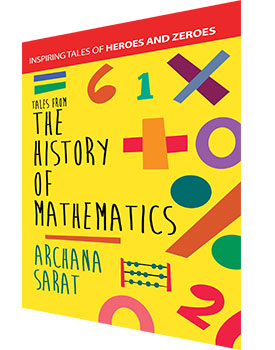Tales from the history of mathematics – Archana Sarat
Readomania publishing, Rs.225, Pages 192
 If there is one subject that evokes strong feelings in most students, it is mathematics. Simply uttering the word ‘maths’ is enough for someone to claim that they love the subject or more often, how much they hated it in school. But irrespective of one’s attitude, Tales from the History of Mathematics by Archana Sarat is a book that will appeal to readers of all ages and preferences. One can even go as far as to say that it might renew an interest in maths of people who have given up hope.
If there is one subject that evokes strong feelings in most students, it is mathematics. Simply uttering the word ‘maths’ is enough for someone to claim that they love the subject or more often, how much they hated it in school. But irrespective of one’s attitude, Tales from the History of Mathematics by Archana Sarat is a book that will appeal to readers of all ages and preferences. One can even go as far as to say that it might renew an interest in maths of people who have given up hope.
“We are all mathematicians,” declares the author in the introduction and she goes on to prove this sentiment in the stories that follow. The book is a compilation of short stories that run a fine line between fiction and non-fiction. Some stories are about fictional characters, but they are placed in historical settings such as the Indus Valley Civilization or Sparta of ancient Greece, which makes them sound authentic. Others are folk tales, while some describe the lives of notable mathematicians such as Euclid and Pythagoras. The variety of these tales makes them informative and entertaining to read.
To assume that Sarat’s book is limited to mathematics would be a mistake. As the title suggests, there is another subject deeply integrated within this book: history. Most tales are supplemented by explanatory ‘know more’ sidebars outlining the factual premise of the chapter. Here, the author explains how maths was used in ancient times and how it has developed by giving the background of the tale, the extent of fictionalisation, the tools of use and other historical details.
The author takes the reader around the world with stories panning Swaziland in Africa, ancient Mesopotamia in Western Asia, the Inca civilization of South America, ancient Greece, Arabia and of course, the source of several significant mathematical discoveries, ancient India.
Indeed a book about the history of mathematics would be incomplete without India’s weighty contribution to the subject. India is the land where zero was invented and used in calculations, where the decimal system was developed and where digits were formulated to denote different numbers, thus giving shape to maths in its present day.
These discoveries are revealed by way of absorbing stories together with accounts of brilliant Indian mathematicians such as Brahmagupta, Bhaskara I and Aryabhatta. Extensive descriptions about the mathematical and technological advances of Harappan civilisation and Vedic geometry recounted in the text of Sulbasutras further demonstrate ancient India’s dominant mathematical prowess.
Another defining feature of the book is the way the author describes famous mathematicians such as Archimedes and Fibonacci. Sarat has researched their lives and discoveries and written simple narratives in an easy to read and comprehensible style.
Especially inspiring for young readers are the chapters on Hypatia, the first woman mathematician of the world as they show how gender never was and never should be, a barrier to education. Interest in a particular subject is natural and should be encouraged in every child, regardless of gender. If Hypatia could do it in the 4th century, what’s stopping girls from becoming mathematicians in the 21st century?
This book has a lucid narrative style. It’s not heavy with illustrations but most chapters are supplemented with simple drawings, especially when there is a need to give a clearer picture of a specific object, shape or building. Further, diagrams are used to substantiate proof of mathematical theorems in a plain, uncomplicated manner. Also included are easy exercises and tips and tricks for quick calculations that have been in use for centuries.
In this collection of tales, Sarat has also touched upon issues of war, murder, slavery and gender disparity, in a straightforward way to inform young readers of life’s realities. She guides the reader through the crucial role that maths has played in simplifying our everyday lives, and how different people and civilisations have contributed to our universal knowledge.
The book shows how maths has crossed cultural, social and regional barriers and will further unleash human talent and potential as future generations build on the principles of mathematics laid down since antiquity.
Ilika Trivedi (The Book Review, October)
Also read: The language of Mathematics



























